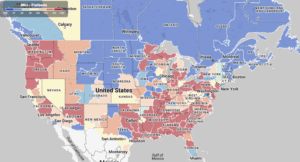Steel output in the U.S. in the week ending July 29, 2023, is up by 1.6% compared with the same time period in 2022, according to the American Iron and Steel Institute (AISI). Adjusted year-to-date production through July 29, 2023, was 51,111,000 net tons at a capacity utilization rate of 75.8%. That is down 2.4% from the 52,362,000 net tons during the same period last year. In flatbed truckload equivalent terms, that’s approximately 41,700 fewer truckloads of steel this year and a significant contributor to lower flatbed demand when combined with fewer single-family homes being built this year.
All other regions reported losses except for the Great Lakes Region, where weekly tonnage was up 4.2% week-over-week (w/w). In the largest steel-producing area in the Southern Region, steel production was down slightly (0.4% w/w). At the state level, Indiana was ranked first in tonnage for June and was down 1.8% m/m and up 1.4% y/y. Ohio was ranked second in tonnage, down 0.1% m/m and up 11.5% y/y, followed by Texas, where tonnage was down 7.1% m/m and up 8% y/y. Except for 2020, when global demand crashed following the pandemic outbreak, national weekly steel production tonnage is the lowest in seven years. Compared to 2019, weekly tonnage this year in Week 30 was 123,000 tons less, or the equivalent of 4,100 fewer weekly truckloads of steel.
Market Watch
All rates cited below exclude fuel surcharges unless otherwise noted.
After dropping for the prior three weeks, linehaul rates in Chicago reversed course last week, increasing by $0.15/mile to $2.59/mile for outbound loads. At $2.56/mile, Joliet reported a similar trend and tightening of capacity, although, on the popular regional haul to St Louis, rates were the lowest in 12 months at $2.63/mile.
In Montgomery, Alabama, rates increased by $0.13/mile to $2.48/mile, while next door in Mobile, rates increased by $0.03/mile to $2.39/mile. At $2.49/mile, state-level rates in Alabama are around $0.10/mile higher than in 2019.
In the Pacific Northwest, capacity tightened rapidly in Medford, Oregon, where rates jumped $0.22/mile to an outbound average of $2.93/mile. Medford to Salt Lake City loads paid carriers $2.64/mile, $0.23/mile higher than in 2022. In Fort Worth, outbound capacity has been steady at $2.19/mile, while capacity tightened slightly in Reno last week, where rates increased $0.02/mile to $2.17/mile.

Load-to-Truck Ratio (LTR)
Flatbed spot market volumes have dropped 17% in the last month following last week’s 2% decrease. Load posts are 64% lower than in 2022, and 34% lower than in 2019. Carrier equipment posts decreased 4% w/w, resulting in last week’s flatbed LTR ratio increasing slightly from 6.75 to 6.85.
Spot Rates
The flatbed spot market continues to soften as volumes plunge and linehaul rates drop, now 16% lower than last year and the lowest this year. After being flat the previous week, flatbed rates dropped $0.05/mile for the second time in three weeks following last week’s decline. At $2.00/mile, the national average flatbed spot rate is $0.39/mile lower than in 2022 and only around $0.09/mile higher than in 2019 – once again, the gap is closing.


